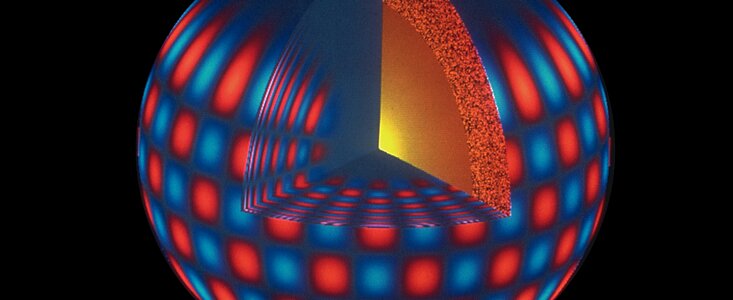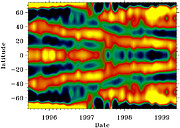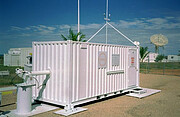The Beat Goes On - Inside The Sun
30 Marzo 2000
Astronomers from the National Science Foundation's National Solar Observatory are announcing in today's issue of Science that their discovery of periodically varying gas motions below the solar surface provides an important clue toward solving the biggest secret of the Sun - the origin of the 11-year cycle of solar activity.
Lead author Rachel Howe, with Frank Hill and Rudi Komm from the National Solar Observatory (NSO) in Tucson, AZ, and colleagues from other institutions, have analyzed 4.5 years worth of observations from the National Science Foundation's Global Oscillation Network Group (GONG), a world-wide network of telescopes providing continuous observations of the Sun, to make this intriguing discovery.
Howe and colleagues have discovered variations in the motion of a region far below the solar surface possibly connected to the solar activity seen on the surface. Probing the depths of the solar interior with a technique known as "helioseismology" which uses sound waves trapped inside the Sun, Howe and her colleagues are able to measure the speed of the gas at different locations below the surface. They then searched for organized, systematic changes in the speed of the moving material. They found that near the base of the convective layer, approximately 30% of the Solar radius or 210,000 km beneath the surface, the rotation rate periodically varies with a cycle of 15 months. Their systematic search looked from the solar surface to nearly half way to the solar core, and from the solar equator to near the pole.
The surface of the Sun rotates about once every 27 days at the equator. Unlike the Earth, however, all points on the solar surface do not rotate at the same rate. The solar equator rotates more rapidly than the poles where the rotation rate is once every 35 days. This "differential" rotation, long a mystery of solar physics, extends throughout the convective layer and then vanishes immediately below it. It is at this transition point that Howe and her colleagues observe the 15-month rhythmic variation of the rotation.
How this pulse in the rotation deep below the surface affects the solar cycle, and why it varies every 15 months instead of 11 years is "another piece of the puzzle for the theorists", explains Howe. "At first we were skeptical of the pattern. Knowing the complexity of models used to explain the solar magnetic field and its connection to observed solar activity, we were expecting nothing, or chaos, in our observations at that location. Using our status as Associate Investigators on NASA's SOHO mission," Howe continues, "we were able to confirm the existence of the periodic variation using an entirely separate instrument and analysis technique. We do believe the pulse is real. We've looked twice in very different ways and see it both times. It's definitely there."
Understanding the solar cycle, which has been recorded since 1750, is a fundamental, and unanswered, question in solar astronomy. Every 11 years the Sun goes from being a relatively quiet place to exhibiting a high level of activity which includes sunspots, solar flares, and coronal mass ejections. At the end of the cycle, the Sun returns to its quiet state. We are at the peak of activity for the current solar cycle, with predicted maximum occurring the Spring of 2000.
The GONG network provides the most systematic, continuous observations of the oscillations of the Sun yet available. Prior to the development of the helioseismology technique central to GONG, most of what we knew about the Sun came from observing the solar surface (photosphere) and the layers immediately above the surface. GONG monitors the surface of the sun 24-hours a day and tracks tiny oscillations on the Sun's surface. These oscillations are visual evidence of sound waves traveling through the sun's interior; by analyzing patterns in the sound waves we can develop an understanding of the conditions of the material the sound waves are traveling through. Many techniques used in current helioseismology are derived from methods developed for studying the effect of earthquakes in a terrestrial setting. In both disciplines, watching the waves of energy being transported through the host sphere, Sun or Earth, gives clues to the density and composition of the material being traversed.
"We listen to the Sun's heartbeat to understand what is happening in its core", explains Frank Hill, NSO astronomer and coauthor on the Science paper. "We can't hear these sound waves on earth because there is no air in between the Sun and earth to carry the sound. (Even if there were, the frequencies are too low to be heard by the human ear.) But, we can see these sound waves in the oscillation patterns on the solar surface."
Howe continues, "Different sound wave patterns occupy different regions in latitude, and different depths within the Sun. By analyzing groups of sound waves in the Sun, we can build up a two-dimensional picture of the rotation inside the Sun".
Más Información
GONG is an international project led by the U.S. National Science Foundation with the participation of twenty nations. GONG observing sites are located at Big Bear Solar Observatory, California; the High Altitude Observatory station at Mauna Loa Solar Observatory in Hawaii; Learmonth Solar Observatory in Australia; Udaipur Solar Observatory in India; the Teide observing station of the Instituto de Astrofisico de Canarias in the Canary Islands, Spain; and Cerro Tololo Interamerican Observatory in Chile. SOHO is a project of international cooperation between European Space Agency and NASA. GONG is a division of the National Solar Observatory (NSO). The National Solar Observatory is operated by the Association of Universities for Research in Astronomy (AURA), Inc. under cooperative agreement with the National Science Foundation.
Contactos
Dr. Frank Hill
NSO Astronomer
Tel: (520) 318-8138
Correo electrónico: fhill@noao.edu
Dr. Rachel Howe
NSO Astronomer
Tel: (520) 318-8573
Correo electrónico: rhowe@noao.edu
Dr. Rudi Komm
NSO Astronomer
Tel: (520) 318-8428
Correo electrónico: rkomm@noao.edu
Suzanne Jacoby
NOAO Press Officer
Tel: (520) 318-8364
Correo electrónico: sjacoby@noao.edu
About the Release
| Release No.: | noao0002 |
| Legacy ID: | NOAO 00-02 |
| Nombre: | Sun |
| Facility: | CTIO GONG |
| Science data: | 2000SoPh..192..427H |






